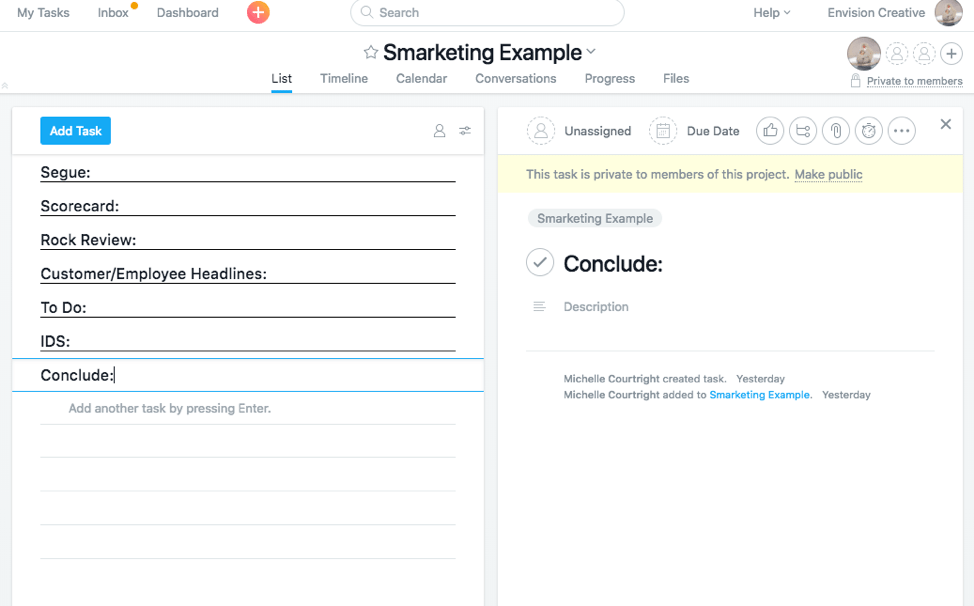Ready to grow your revenue by 20% with one, simple strategy? If you said no, go sit in a corner and think about what you’ve done. If you’ve said yes, because you are a human being who wants to succeed, then we have one word for you: Smarketing.
Full disclosure: smarketing is a dumb word. It sounds kind of like what Smurfs do when they’re looking to re-brand but bear with us here.
What we’ll cover: why alignment with sales and marketing is crucial, what a smarketing meeting is, and how to run one effectively. Do these things and you’ll be a total rock star to your team (and your boss).
Smarketing 101: Why alignment with sales and marketing is crucial
If you haven’t guessed by now, Smarketing is the portmanteau given to the combination of Sales and Marketing. While this seems like a total no-brainer, if you’ve worked in an environment with both a marketing and a sales team, you’ll know that they are often siloed and, sometimes, fiercely competitive.
While competition is healthy and can spur results and innovation, it can also be a hurdle that prevents vital details from being communicated and can result in the loss of revenue and missed opportunities to streamline your business and increase your lead flow.
What is a Smarketing Meeting?
A Smarketing Meeting is a meeting that brings your Sales and Marketing teams together to talk about campaigns, projects, challenges, and solutions.
Who should be at this meeting?
It depends on the size of your company. For us, the entire marketing and sales team meets together. We have a relatively small team, so it’s easier for us to get into our boardroom and hash it out.
For larger companies, it’s recommended that only a few members of each team attend your Smarketing meeting. Let the leaders of each team select the members that are the most likely to communicate and share their thoughts during the meeting. If your team is FULL of these types of awesome communicators then you can rotate them out for every meeting so that a variety of voices are heard.
People NOT to invite:
- The big bosses: Why? Because people are less likely to talk about challenges and share their true thoughts if the boss is around. More than likely, the meeting would devolve into polite chatter and cheerleading to leave a more positive impression and real problem solving would not get done.
- Passive observers: If there are team members that would rather observe the conversation than be a part of it, they’re not the best fit for this meeting. You want (and need) members who actively contribute.
- The stubborn “expert”: There are always members who do things the way they want to do things and don’t see the need to change anything. While it’s important to get these team members on board with new strategies, it can often be a negative force in the room when ideas are being shared.
How often should we have it?
Once a month is best, but if it’s not feasible try to do this once a quarter. The key point is to make this meeting USEFUL and RELEVANT to your teams. Over-scheduling your teams with meeting upon meeting takes time away from the work that needs to get done for your clients.
This doesn’t mean that Sales and Marketing should only talk to each other once a month! Our marketing and sales teams often communicate via quick chats face to face or via Slack about ideas for campaigns and quick strategy sessions for new prospects. We noticed this happening more and more frequently once Smarketing became a thing and both teams are happier with the increase in communication (and so are our clients!).
How do I run a Smarketing Meeting?
We don’t want to tell you what to do (just kidding, this is the point of this section) BUT we do advocate the use of the Level 10 structure used in Traction. Not using Traction? Not a problem! You can use whatever meeting structure makes sense for your team—OR, you don’t have to adopt the complete EOS to run a Level 10 meeting. We’ll outline how we do it and you can adopt it or adapt it in any way you see fit.
Regardless of the form you take, setting an agenda and sticking to it is critical. The moment these meetings get too in the weeds is the moment it ceases to become useful and you’ll lose the buy in from your teams.
There are two main roles that need to be filled for this meeting:
1. A Leader: This person will, obviously, lead the meeting. Keeping it on track and sticking to the agenda is key for this position so make sure the person who leads the meeting is on top of the topics and can command the room in a way that keeps things moving (without being too aggressive).
2. A Driver: The Driver is an important part of this. As you go through the meeting the Driver will be creating tasks, taking notes, clicking to different sections of the agenda, and bringing up documents (when part of the meeting). The point of the driver is to free the leader to lead the meeting without the distraction of note and task making.
The good stuff: Set-up and agenda for your first Smarketing Meeting
The goods news it that not only do you NOT need one million tools for this, but you probably already have a tool in place you can use! If you have a project management platform, this is the best place to create and track your Smarketing meeting agendas.
Don’t have a PM platform? No problem! Here are some FREE platforms out there:
- Asana (this is what we use and will be shown in the screenshots)
- Google Documents
- Basecamp
- Smartsheets
- Trello
There are more, of course, but these are the easiest.
The starting template looks simple enough:

Pretty simple, right? As you can see, there are 7 sections:
1. Segue
2. Scorecard
3. Rock Review
4. Customer/Employee Headlines
5. To Do
6. IDS
7. Conclude
In the next section we’ll be providing definitions, examples, and how tos for each of these parts of the meeting.
Let’s go!
The Smarketing Meeting Agenda
Segue: 5 minutes

- What: A five-minute introduction to the meeting, a kind of social beginning.
- Who: Each attendee should add theirs to the list PRIOR to the meeting
- Action: Mention one personal (safe for work!) and one professional accomplishment from month
- Why: This helps in a couple of ways:
- It helps get chatter out of the way right away.
- By sharing this type of content, it allows the teams to get to know one another and build a strong relationship which benefits them both in and out of the meeting.
Scorecard: 5 minutes

- What: A document (ideally a spreadsheet) set up with your KPI goals for the quarter for your Smarketing team. The “scorecard” keeps track of your progress in achieving these metrics.
- Who: The Driver should bring up the scorecard, so the Leader can quickly review them.
- Action: Any metric that is not on track should be added to IDS for discussion.
- Why: this is a quick way to make sure the team is achieving its goals and gives the group an opportunity to discuss challenges in the IDS if things are off track.
Rock Review: 5 minutes

- What: An overview of your Smarketing team’s goals, or rocks in EOS speak. This differs from the scorecard because the Rocks are projects like “Creating new personas” or “Updated inbound workflows” where the scorecard is for specific metrics like MQL and SQL goals for the quarter.
- Who: The Leader should call out each rock title and a team member should say if it’s on or off track for the end date set.
- Action: If a rock is off, it should be added by The Driver to IDS.
- Why: Like with the scorecard, this helps provide transparency on progress and provides an opportunity to identify and discuss challenges sooner rather than later.
Customer/Employee Headlines: 5 minutes

- What: A quick report about clients, projects, campaigns that are in motion.
- Who: Each team member should briefly describe their headline in one sentence. If more discussion is needed, The Driver should add it to the IDS.
- Action: Each team member reviews their headline which should be added PRIOR to the meeting.
- Why: This helps everyone stay up to date on what is happening without getting too far off track in the discussion of non-vital details.
To Do List: 5 minutes

- What: A to do list of tasks from the previous meeting for the attendees/projects.
- Who: The Leader should review each task in this list.
- Action: The assignee says “Done” or “Not done.” The Driver should move incomplete tasks to IDS for further discussion.
- Why: Accountability. This ensures that everyone knows what’s being done and what’s not being done.
- Note: This should not be a negative or punitive action—if a task is not done and needs to be moved to IDS it’s in the spirit of helping it get done and not calling out the person who has fallen behind.
IDS: 60 minutes

- What: Identify, Discuss, and Solve! This is where issues that require discussion should be moved! The point of the Level 10 is to get through the other sections to allow as much time as possible for this!
- Who: The Leader should help the team prioritize these from most important at the top of the list and least important on the bottom.
- Action: The Driver should take notes in the task and create To Dos if needed (to be put into the To Do section for the next meeting!)
- Why: This is the most critical part of the meeting. Keeping things on track with the other sections ensures that you have as much time as possible to identify, discuss, and solve the issues in this list.
- Note: If an issue can’t be solved with the present group, roll it up to management for further review.
Conclude: 5 minutes

- What: The end, dummy!
- Who: The Leader will review the To Do list for the next meeting.
- Action: Each attendee then rates the meeting from 1-10—1 being poor and 10 being extremely effective and productive.
- Why: Wrapping up, reviewing next steps, and rating the meeting help provides a natural and actionable conclusion. Review your meeting ratings to make sure you’re on the higher level of the scale—if not, see how you can improve!
Now, get it done!
Now that you have the idea, make it happen! If you’re already running a Smarketing meeting, let us know how you do yours and you could be featured on our social media!
-FINAL(01-00)-White&Blue-01.svg)





